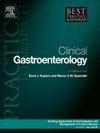Cost-effectiveness of upper endoscopy for gastric cancer screening and surveillance in Western populations
IF 3.2
3区 医学
Q2 GASTROENTEROLOGY & HEPATOLOGY
Best Practice & Research Clinical Gastroenterology
Pub Date : 2025-03-01
DOI:10.1016/j.bpg.2025.101982
引用次数: 0
Abstract
Background
Gastric cancer (GC) is the fourth leading cause of cancer-related deaths worldwide, with highest incidence rates in Asia. Endoscopic screening may facilitate early detection and reduces mortality, but its cost-effectiveness in Western populations, where GC is less prevalent, remains unclear. This review aimed to evaluate the cost-effectiveness of endoscopic screening and surveillance for GC in Western countries, considering regional epidemiologic and economic differences.
Methods
A systematic search of literature was conducted using PubMed and Embase databases, focusing on studies evaluating the cost-effectiveness of endoscopy in asymptomatic individuals or high-risk subgroups in Western populations. Studies reporting incremental cost-effectiveness ratios (ICERs) compared to no screening/surveillance were included.
Results
In total fourteen studies were evaluated. Six studies reported on endoscopic screening in the general population, three on screening in high-risk individuals, and seven on endoscopic surveillance, with varying intervals ranging from one-time procedures to procedures every ten years. Endoscopic screening was generally not cost-effective in Western populations. However, screening for high-risk subgroups, or combined with colonoscopy, following a positive fecal immunochemical test, improved cost-effectiveness. Endoscopic surveillance was consistently cost-effective, particularly for individuals with gastric intestinal metaplasia (GIM), showing the best cost-effectiveness at a three-to five-year interval, with ICERs ranging from €18,336 per Quality-Adjusted Life Year (QALY) in Europe to $87,000 per QALY in the USA. For higher-risk lesions, like dysplasia or incomplete GIM, shorter surveillance intervals may be beneficial.
Conclusion
While routine endoscopic screening may not be cost-effective in Western populations, surveillance for GIM every three to five years is economically sustainable. Higher-risk individuals with dysplasia or incomplete GIM may benefit from more frequent surveillance.
在西方人群中,上胃镜用于胃癌筛查和监测的成本-效果
胃癌(GC)是全球第四大癌症相关死亡原因,亚洲发病率最高。内窥镜筛查可能有助于早期发现并降低死亡率,但其在胃癌发病率较低的西方人群中的成本效益尚不清楚。考虑到地区流行病学和经济差异,本综述旨在评估西方国家内镜筛查和监测胃癌的成本效益。方法使用PubMed和Embase数据库系统检索文献,重点研究评估西方人群中无症状个体或高危亚群内窥镜检查的成本-效果。研究报告了与不进行筛查/监测相比的增量成本-效果比(ICERs)。结果共评价了14项研究。6项研究报道了普通人群的内窥镜筛查,3项研究报道了高危人群的内窥镜筛查,7项研究报道了内窥镜监测,时间间隔从一次到每十年一次不等。内窥镜筛查在西方人群中通常不具有成本效益。然而,在粪便免疫化学试验阳性后,对高危亚群进行筛查或联合结肠镜检查可提高成本效益。内镜监测始终具有成本效益,特别是对于胃肠道化生(GIM)患者,在三到五年的间隔内显示出最佳的成本效益,ICERs从欧洲的每个质量调整生命年(QALY) 18,336欧元到美国的每个QALY 87,000美元不等。对于高风险病变,如发育不良或不完全GIM,较短的监测间隔可能是有益的。结论:虽然常规内镜筛查在西方人群中可能不具有成本效益,但每3 - 5年进行GIM监测在经济上是可持续的。患有发育不良或不完全GIM的高风险个体可能受益于更频繁的监测。
本文章由计算机程序翻译,如有差异,请以英文原文为准。
求助全文
约1分钟内获得全文
求助全文
来源期刊
CiteScore
5.50
自引率
0.00%
发文量
23
审稿时长
69 days
期刊介绍:
Each topic-based issue of Best Practice & Research Clinical Gastroenterology will provide a comprehensive review of current clinical practice and thinking within the specialty of gastroenterology.

 求助内容:
求助内容: 应助结果提醒方式:
应助结果提醒方式:


